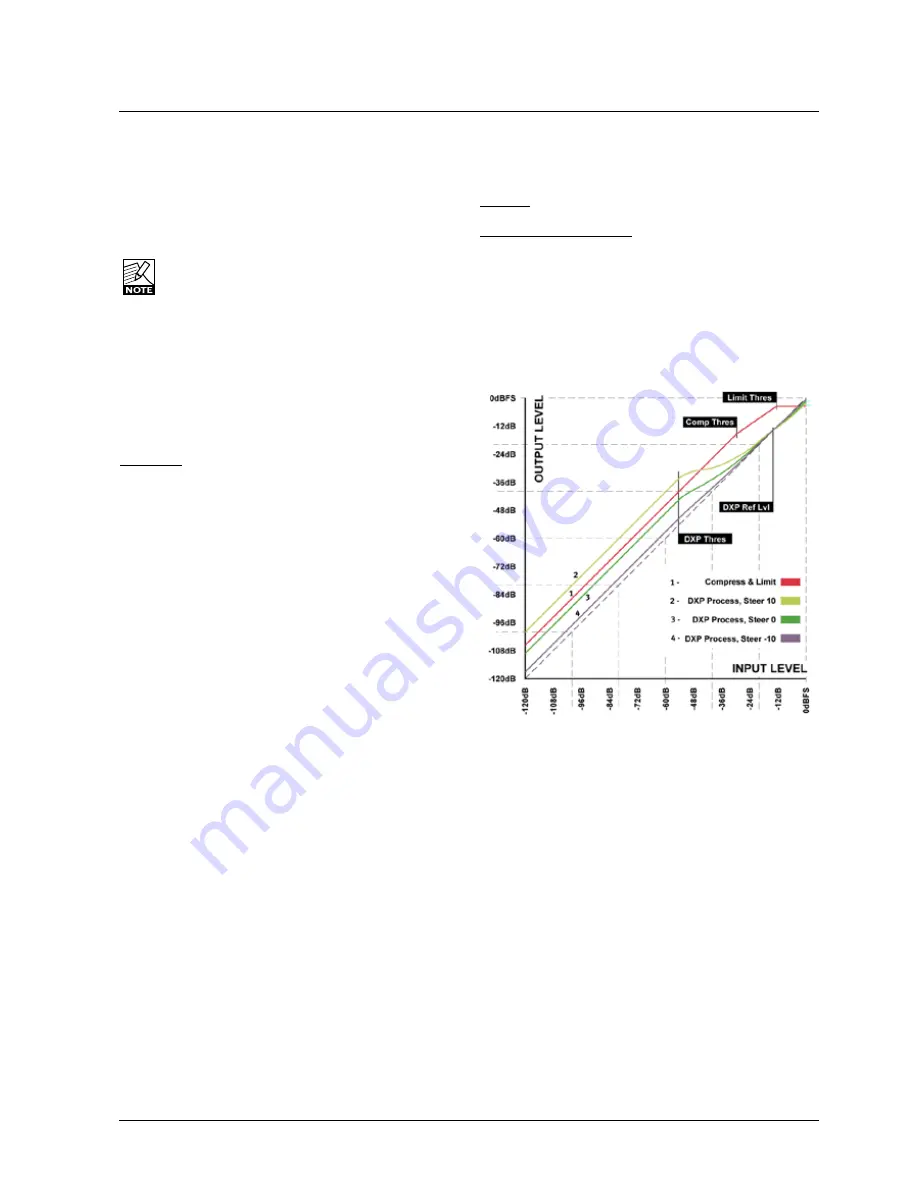
47
MD-4
delay influenced “wet” part of the signal. Inside the
algorithm, before the limiter, the “dry” and “wet” signals are
summed.
When Trim and Band gains are all 0.0 dB, gain through
MD-4 in parallel mode is unity, provided the signal is below
the Threshold of compression.
Users have suggested an alternative calculation of
gain for Parallel Mode, namely to provide unity gain
with Trim at 0.0 dB, and all Band Gains at Off. If
you too prefer parallel compression to be purely
additive, walk this way: Set Trim at +6.0 dB, and
turn all Band Gains Off. This will cause gain to be
unity. Now, use the Band Gains to add gain. In this
case, +6 dB will be reached when the Band Gains
are at 0.0 dB. If the current way of setting gain in
Parallel Mode is changed in a future software
update, information will be provided to translate
presets based on the 3.50 gain structure.
DXP mode
DXP Mode is a new five-band detail enhancer with an
integrated Brickwall 2 Limiter at its Output. DXP Mode
was designed as an alternative to traditional dynamics
processing - to lift up low level subtleties rather than
boosting and limiting elements that are already loud.
As seen on the level diagram, an inactive processing
area is available above the Reference Level but below
the Threshold of Limiting, so material neither too soft, nor
too loud can be left unaltered. Consequently, DXP mode
offers a flexible tool for hi-res processing, which may be
used with good results even on sensitive material such
a classical or other types of acoustic music. Used on
spoken word or singing, DXP mode can improve speech
intelligibility, and add extra character and expression.
Individual frequency bands may have different detail
enhancement applied, and DXP can be combined with MS
discrimination, for instance to lift up low level de-correlated
components (wide=S) such as ambience, or to treat fully
correlated components (center=M) in a certain way. Preset
examples can be found in Engine Factory Bank 10,
decade 5.
DXP processing doesn’t add anything to the signal that
isn’t there already. It merely magnifies the details or
spectral components which previously may have been
masked. Like Normal and Parallel mode, resolution of DXP
mode is 48 bit fixed point to maintain a processing margin
over the source material.
From a users point of view, this mode introduces a new
parameter on each band, Steer, instead of Threshold.
Steer determines the slope and boost of that particular
band as shown in the level diagram. Bands hit unity gain (0
dB gain) at the Reference Level, so low level boosting only
takes place below that level, and is at the max below each
band’s Threshold. Note: Unity gain depends on the crest
factor of the input signal. Reference Level should be set
approximately 2 dB lower if a unity gain point is determined
with a tone. Alternatively, Band Gains may be trimmed
down by the same amount.
If low level Steer gain brings up too much noise, a Defeat
function is available to revert to unity gain a certain number
of dB below the DXP threshold.
Example
:
With the following settings:
- Limit Threshold set at -3 dBFS,
- Reference Level at -12 dBFS,
- DXP Threshold at -14 dB and
- Defeat at -20 dB,
there will be unity gain between -12 dBFS and -3 dBFS,
and full low level gain between -26 and -46 dBFS. The
slope with which MD4 reverts to unity gain below -46 dBFS
is determined by the Defeat Ratio.
Look Ahead Delay
Range: 0 to 15ms
Look Ahead Delay introduces an audio delay to allow
processing to take place at precisely the right time. It
influences the 5 Band section regardless of its mode of
operation (Normal, Parallel and DXP plus gain Defeat). The
Brickwall limiter at the output is independent of this setting,
and uses a its own look ahead.
Each of the 5 bands has its own look ahead delay, which
can never be longer than the Look Ahead Delay parameter.
However, look ahead in the individual bands may be
shorter than that to prevent attack to operate “ahead of
time”. For example, if Look Ahead Delay is set at 10.0 ms,
and Attack in the Hi Band at 3.0 ms, that particular band
will only use a little more than 3 ms of the look ahead delay
it has at its disposal. The actual audio delay is of course
always the same in all 5 bands.
Tip: If Attack times of double the Look Ahead Delay or
less are used in the 5 Band section, this setting may have
a big influence on MD4’s peak handling and therefore
sound. However, if longer Attack times have been chosen,
Look Ahead Delay will not make much difference to the
processing - besides from introducing a delay in the signal






























